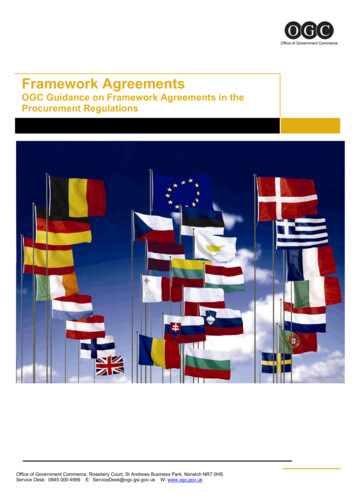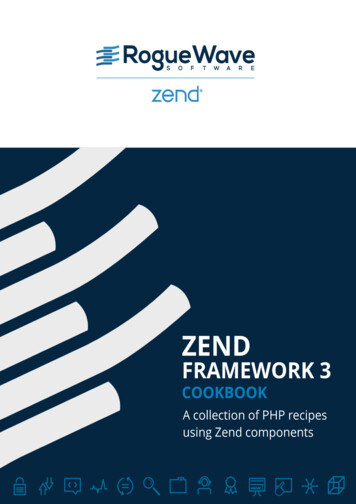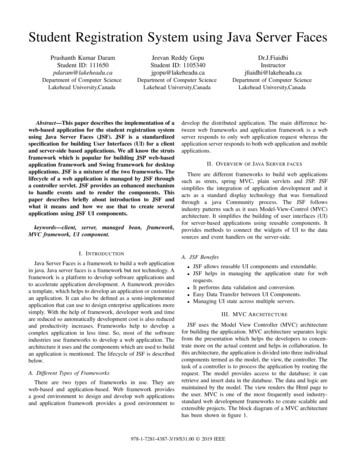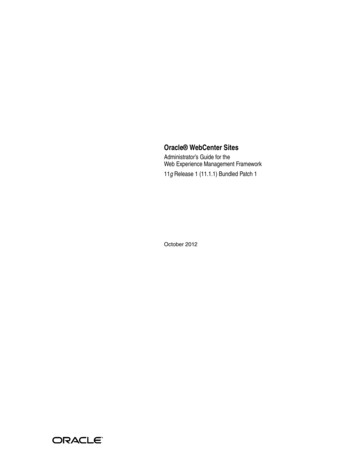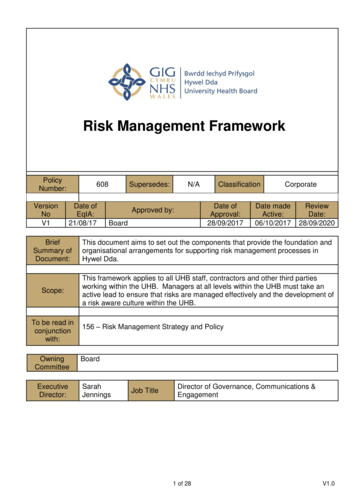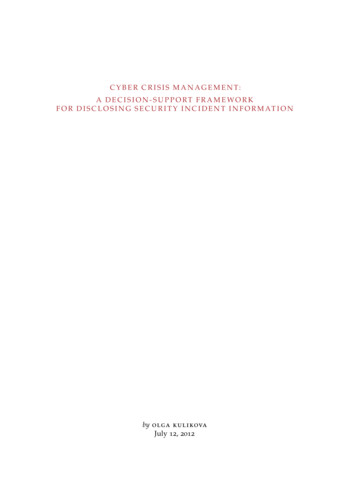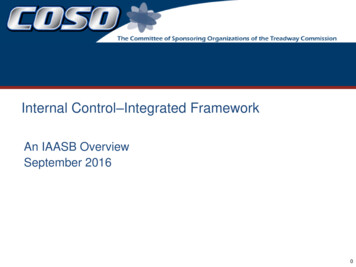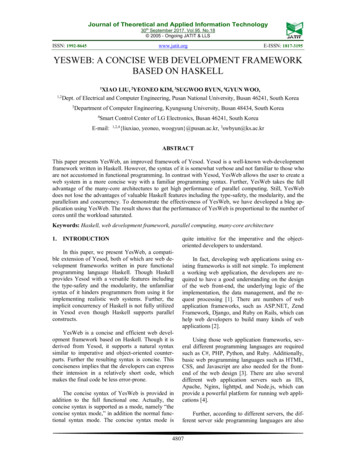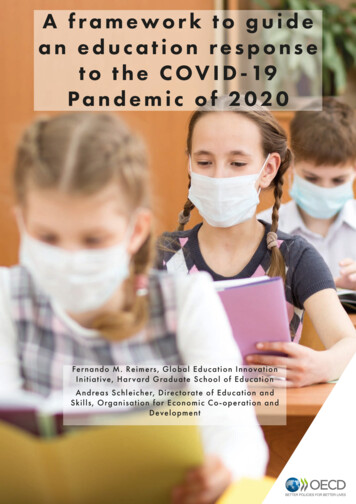
Transcription
A framework to guidean education responset o t h e C O V I D - 19Pandemic of 2020Fernando M. Reimers, Global Education InnovationInitiative, Har vard Graduate School of EducationAndreas Schleicher, Directorate of Education andSkills, Organisation for Economic Co-operation andDevelopment
SummaryThis report aims at supporting education decisionmaking to develop and implement effectiveeducation responses to the COVID-19 Pandemic.The report explains why the necessary socialisolation measures will disrupt school-basededucation for several months in most countriesaround the world. Absent an intentional andeffective strategy to protect opportunity to learnduring this period, this disruption will cause severelearning losses for students.The report proposes that leaders of educationsystems and organizations develop plans forthe continuation of education through alternatemodalities, during the period of necessary socialisolation. It offers a framework of areas to becovered by such plans.Based on a rapid assessment of education needsand emerging responses in ninety eight countries,the report identifies the most salient needs thatshould be addressed in these plans, as well asthe areas likely to face more implementationchallenges. It also examines the educationresponses of various countries to the crisis. Basedon an analysis of data from the most recentadministration of the PISA survey, the report alsodescribes the challenges facing various educationsystems to depend on online education as analternative modality.
A framework to guide an education response to the COVID-19 Pandemic of 2020IntroductionAs the COVID-19 Pandemic ravages the world, itis essential to attend to the educational needs ofchildren and youth during the crisis. This documentis intended to support education leaders at variouslevels of educational governance, in public and privateeducational organizations, in formulating adaptive,coherent, effective and equitable education responsesto a crisis that will significantly disrupt educationalopportunities globally.To be sure, the COVID-19 Pandemic is first andforemost a matter of Public Health, and mitigating itsimpact will depend greatly on the actions of scientistsand pharmaceutical manufacturers in discovering avaccine or other pharmaceuticals to prevent or treatCOVID-19 infections, and of finding approaches todelivering such medicines on a broad scale. Absenteffective pharmaceutical interventions, mitigating theimpact of the Pandemic will depend on the actionsof public health and government officials in slowingdown the spread of infection, through measures suchas social distancing.“These large-scale non-pharmaceutical interventionsvary between countries but include social distancing(such as banning large gatherings and advisingindividuals not to socialize outside their households),border closures, school closures, measures to isolatesymptomatic individuals and their contacts, and largescale lockdowns of populations with all but essentialinternal travel banned.”Because the forecasts of the development of a vaccineplace it at best in September of 2020, a full sixmonths ahead, the main strategy available to preventrapid spread of infections in the near future will likelyconsist of social distancing. While this strategy, ifadopted by all or most of the population, is likely tosucceed in slowing down the velocity of infection, asdemonstrated in China, Japan, Korea and Singapore,its efficacy depends on timely and effective leadershipby political leaders and on a receptive and disciplinedresponse by citizens. The evidence on leadership andfollowership in various countries around the world ismixed, at least to date, which will require continuedsocial distancing measures and will extend the durationof the Pandemic and augment its impact. Current andexpected infections and deaths at present and inthe coming months are dire. The Center for SystemsScience and Engineering at John Hopkins Universityreports 788,522 confirmed cases globally, and37,878 deaths, as of March 30, 2020 . Researchersat Imperial College in London, estimate the globalimpact in the year 2020 to range between 20 milliondeaths, with effective non-pharmaceutical interventionsin place, and 40 million deaths, without suchinterventions . In the United States alone, Dr. AnthonyFauci, Director of the National Institute of Allergy andInfectious Diseases, estimates that the Pandemic willcause between 100,000 and 200,000 deaths .As a result of the scale of the impact of the Pandemic,this is not just a matter of Public Health. The Pandemic,and the necessary responses to contain it, will impactsocial, economic and political life. The restrictions onmobility created by social distance have diminishedeconomic supply and demand, severely impactingbusinesses and jobs. This impact will be harder in themost vulnerable populations within countries, and in thecountries with the weakest health infrastructures.The restrictions caused by non-pharmaceuticalinterventions like social distancing have also impactededucation at all levels, and will continue to do sofor at least several months, as learners and teachersare unable to physically meet in the schools anduniversities.These limitations in the ability to meet during aprotracted pandemic will likely limit opportunitiesfor students to learn during the period of socialdistancing. It is well known that time spent learning, orlearning time, is one of the most reliable predictors ofopportunity to learn. In the United States, researchershave documented the effects of ‘summer learningloss’ demonstrating that extended interruption of one’sstudies causes not only a suspension of learning time,but causes a loss of knowledge and skills gained.A review of research on summer learning loss in theUnited States, demonstrates that during the summervacation students lose the equivalent of one month ofacademic year learning, the loss is greater in math thanin reading, and the loss increases with grade. The lossis also greater for lower income students .Furthermore, differences among students in supportfrom parents who can provide for them educationalopportunities directly at home or accessing themprivately, differences in the capacity of differenttypes of schools to support the learning of theirstudents remotely, and differences among studentsin their resilience, motivation and skills to learnindependently and online, are likely to exacerbatealready existing opportunity gaps. In addition,differences across school systems in their capacity to OECD 20203
A framework to guide an education response to the COVID-19 Pandemic of 2020design and implement effective education responsesduring the exigency, will amplify gaps in opportunityacross jurisdictions. As a result, absent an intentionaland effective education response, the COVID-19Pandemic is likely to generate the greatest disruptionin educational opportunity worldwide in a generation.This disruption will impact the livelihoods of individuals,and the prospects of their communities.It is imperative, for this reason, that education leaderstake immediate steps to develop and implementstrategies which mitigate the educational impact ofthe Pandemic. We believe that cooperation can assisteducation leaders in devising effective educationresponses, and that the first and simplest form ofcooperation is to exchange knowledge about whatschools, communities and countries are currentlydoing to protect educational opportunities during thepandemic.The purpose of this document is to support suchprocess of exchange of knowledge. This documentcontains a framework to guide the development ofcontext-specific education strategies, supported bythe results of a rapid assessment conducted betweenMarch 18 and March 27 of 2020. The assessmentsurveyed respondents online about the educationchallenges created by the Pandemic, about theirresponses to those challenges, and about resourcescurrently being used to advance education through4 OECD 2020alternative means. The survey we designed for thispurpose is presented in Appendix A. The survey wasdistributed via networks of educators and influencers,those in the networks of the OECD and of theGlobal Education Innovation Initiative at the HarvardGraduate School of Education, with assistance fromcolleagues in several education organizations suchas Save the Children, WISE, and others. While thesurvey does not represent jurisdictions or stakeholdergroups, its goal was to include respondents reflectinga variety of perspectives and positions in the educationsector. Respondents were asked to provide informationthat served to characterize their vantage point, theirposition, institution, the country their responses referredto, the level of government to which their responsesreferred. They were also asked to provide an emailaddress for contact. Only those surveys who includedresponses to the majority of the questions, and whocharacterized their vantage point, were included.Below we offer a checklist to guide the developmentof an education strategy during the Pandemic. Thiscan be used by national, state or local educationauthorities or by leaders of education networks.In countries where international developmentorganizations partner with governments to supporteducational development, they can take on the role ofassisting in the development of the education response.
A framework to guide an education response to the COVID-19 Pandemic of 2020A checklist for an education response to theCOVID-19 Pandemic1.Establish a task force or steering committeethat will have responsibility to develop and implementthe education response to the COVID-19 Pandemic.To the extent possible ensure those in the task forcerepresent different constituents in the educationsystem or school network and bring important anddiverse perspectives to inform their work, for examplevarious departments curriculum, teacher education,information technology, teacher representatives, parentrepresentatives, students, representatives of industrywhen relevant.2.Develop a schedule and means of frequentand regular communication among task forcemembers, during the period when social distancing willbe in effect.3.Define the principles which will guide thestrategy. For example: protecting the health of studentsand staff, ensuring academic learning and providingemotional support to students and faculty. Theseprinciples will provide focus for the initiatives to beundertaken and will help prioritize time and otherlimited resources.8.Clearly define roles and expectations forteachers to effectively steer and support students’learning in the new situation, through direct instructionwhere possible or guidance for self-directed learning.9.Create a website to communicate withteachers, students and parents about curriculum goals,strategies and suggested activities and additionalresources.10.If an online education strategy is not feasible,develop alternative means of delivery, they couldinclude TV programs, if a partnership with televisionstations is feasible, podcasts, radio broadcasts, andlearning packets either in digital form or on paper.Explore partnerships with community organizationsand the private sector to deliver those.11.Ensure adequate support for the mostvulnerable students and families during theimplementation of the alternative education plan.12.Enhance the communication andcollaboration among students to foster mutual learningand well-being.4.Establish mechanisms of coordination withpublic health authorities so that education actionsare in synch and help advance public health goalsand strategies, for example, educating students,parents, teachers and staff on the necessity for socialdistancing.13.Create a mechanism of just in timeprofessional development for teachers and for parentsto be able to support learners in the new modalityof instruction. Create modalities that foster teachercollaboration and professional communities and thatincrease teacher autonomy.5.Re-prioritize curriculum goals given the realitythat the mechanisms of delivery are disruptive. Definewhat should be learned during the period of socialdistancing.14.Define appropriate mechanisms of studentassessment during the exigency.6.Identify the feasibility of pursing options torecover learning time once the social distancing periodis over, for example, an intensive review period duringthe break prior to the start of the new academic year.7.Identify means of education delivery. Whenfeasible, those should include online learning, asit provides the greatest versatility and opportunityfor interaction. If not all students have devices andconnectivity, look for ways to provide them to thosestudents. Explore partnerships with the private sectorand the community in securing the resources to providethose devices and connectivity.15.Define appropriate mechanisms for promotionand graduation.16.As needed, revise regulatory framework inways that make online education and other modalitiesfeasible, and in ways that support teacher autonomyand collaboration. This includes providing school daycredit for days taught in alternative education plans.17.Each school should develop a plan forcontinuity of operations. As a way to support them,education authorities can provide curated examples ofplans in other schools.18.When the school provides meals to students,develop alternative means of distribution of food to OECD 20205
A framework to guide an education response to the COVID-19 Pandemic of 2020students and their families.19.When the school provides other socialservices, such as mental health supports, developalternative forms of provision.20.Schools should develop a system ofcommunication with each student, and a form ofchecking-in daily with each student. Perhaps in theform of texts from teachers if parents have access tomobile phones.21.Schools should develop mechanisms of dailychecking in with teachers and school staff.22.Schools should provide guidance to studentsand families about the safe use of screen time andonline tools to preserve student well-being and mental6 OECD 2020health as well as provide protection from online threatsto minors.23.Identify other school networks or systems andcreate forms of regular communications with them toshare information about your needs and approachesto solve them, and to learn from them as a way tofoster rapid improvement in delivering education in thenew modalities.24.Ensure that school leaders get the financial,logistical and moral support they need to succeed.25.Develop a communications plan. Mapkey constituencies, and key messages to supportthe execution of the education strategy duringthe exigency,and ensure those are effectivelycommunicated through various channels.
A framework to guide an education response to the COVID-19 Pandemic of 2020Priority responses by countries1.Education leaders should adopt a proactiveapproach to contributing to the mitigation of theimpact of the Pandemic and to prevent learning lossduring the period of necessary social distancing. Theyshould also contribute to the creation of opportunitiesto help reskill those displaced by the Pandemic andfacilitate their reintegration into the labor market.To execute on these goals education departmentswould benefit from establishing an agile leadershipgroup or steering committee in charge of overseeingthe education response to the Pandemic, develop astrategy with clear implementation plans, monitor theimplementation of the strategy, and where possibleengage with similar groups in other educationjurisdictions to access knowledge about similarefforts ongoing and their results, and accelerate theirlearning and ongoing improvement of their strategy.Because a Pandemic is the quintessential adaptivechallenge, creating opportunities for rapid learningand continuous improvement is necessary. Also, inaddressing this adaptive challenge, collaboration willbe essential, everyone will need to step up, get out ofthe comfort zone, in order to get the job of educatingstudents done. It may be advisable to structure thework of this task force in two different time horizons.The first one, most immediate, focused on completingthe ongoing academic year. The second one, focusedon the following academic year in the event a vaccinehas not been developed prior to starting it and thatsocial distance measures continue to be necessary.These different timeframes should also influence thevarious options to be deployed. For example, in theshort term, in the countries or school systems that donot already have an existing infrastructure to supportonline learning and universal access to devices, it isunlikely that online education can be deployed todeliver education. Other modalities will be necessary,of lower cost and relative ease of implementation,such as radio education or educational television. Inthe medium term, however, it is possible to provide theinfrastructure for online learning, an investment whichis likely to have benefits that extend well beyond thecurrent predicament.2.An effective public health response requiressupport from education institutions. Education systemsshould be working in coordination with public healthauthorities to educate students, parents, teachers,and the general public about the necessity of nonpharmaceutical interventions such as social distancingto curb the velocity of contagion.3.An education strategy should prevent learningloss resulting from non-pharmaceutical interventionsto mitigate the impact of the Pandemic, which is likelyto be considerable, equivalent at a minimum to twomonths of academic learning and potentially more. Itshould be recognized, however, that the extraordinarycircumstances under which any likely alternativemodality of education could be continued during thePandemic, make it virtually impossible for systems andinstitutions to achieve the same goals. This requiresreprioritizing curricular goals and defining what shouldbe learned during the period of social distancing.To do so, every school should have a plan to ensurecontinuity of operations during the Pandemic. Schoolscould be supported in developing such plans forcontinuity by curating and providing access to similarplans developed by other schools. For example, aschool in Atherton, California, explains how they drewon comparative analysis to develop their plan:"Greetings from Silicon Valley. In the spirit of sharingand international collaboration, we’re sending outour Flexible Plan for Instructional Continuity at SacredHeart Preparatory, Atherton. Our plan is the productof collaboration with colleagues on our campusand around the world. We have built on our ownexperience and the experiences of others. Our planis based on known best practices for face-to-faceand remote instruction. But also, it responds to lessonslearned from colleagues at international schools andschools around the world who suddenly had to closefor multiple weeks at a time as a result of pandemic.We are grateful to our teaching colleagues aroundthe world who have generously offered their insightsand experiences, most especially the Taipei AmericanSchool in Taiwan and the Concordia InternationalSchool in Shanghai."4.Second only to supporting learning, a keypriority of education institutions should be the wellbeing of students and staff. Maintaining effective socialrelationships between learners and educators willcontribute to that goal. A protracted pandemic, and itsmultiple effects in the health, income and well-beingof individuals and communities, is likely to strain thepsychological reserves of all, including students andteachers. Educators and leaders of education systemsshould make explicit and visible their goals for wellbeing, and pursue strategies that help maintain wellbeing in the face of a global health event that will havea considerable toll in the lives and health of individuals,which may include members of the communities in OECD 20207
A framework to guide an education response to the COVID-19 Pandemic of 2020which students live. As such impact becomes proximalto every learner and educator, this may impact theirmotivation and functioning. For this reason, continuingeducational activities, in some form, may contribute tothe well-being of students during the crisis, maintaininga sense of normalcy and regularity in an otherwiseunpredictable situation where the normal functioning ofindividuals is constrained by the limitations on mobility.The development of skills, attitudes and valuespurpose, resiliency and self-efficacy, should beexplicitly cultivated through activities that fosterconnection and affirmation. There is a potentialtradeoff between ensuring well-being and significantlyincreased screen time derived from a transition todistance learning. Education systems and institutionsneed to decide the right balance with respect to thistradeoff. It will also be desirable to explicitly suggestthat institutions provide guidance to parents andstudents about the safe use of online tools, socialnetworking, television and video gaming.5.It is imperative to support forms oforganization that provide students time to engagein predictable and structured learning opportunities.When possible, those should draw on on-lineactivities because they provide the richest modalityfor interactive learning. Achieving this would requireensuring access to devices and connectivity for thestudents who do not have them. When this is notpossible, other modalities such as television, radio,podcasts, DVDs and learning packets should be usedfor the delivery of educational content to students.This content should be designed to provide studentsopportunities for response and interaction. It maybe necessary to have two different strategies for theshort and medium term, in the event the Pandemic isnot controlled before the start of the next academicyear. In the short term, there it is likely not feasible tocreate an infrastructure of connectivity and to providedevices to all students in systems where those are notalready available. As a result, it may be necessaryto depend on lower cost technologies such as radioand educational television. However, it is imperativeto invest in the development of such infrastructurewhere it is lacking, something which is difficult to doout of the ordinary education budgets, but which theresponse to this Pandemic may contemplate as anessential investment. This investment could providedevices to students and teachers and connectivity,to support a model of online learning that allowsthe greatest possible interaction in real time amongstudents, among students and teachers, and withparents, as well as the creation of school networks andprofessional teacher communities across schools.8 OECD 20206.The role of teachers is essential to the successof the learning experience, even more so than thephysical environment of schools or the technologicalinfrastructure. When the structuring power of timeand place that schools provide, dissolves and onlinelearning becomes the dominant mode, the role ofteachers does not diminish, quite on the contrary.Through direct instruction or through guidanceprovided in self-directed learning, in synchronous orasynchronous modes, the teacher remains essential insteering students’ learning.7.It is critical to facilitate teacher professionalcollaboration and learning, and to provide teacherswith access to resources and online platforms forcollaboration (technology and curated educationresources) so they can keep abreast of the rapidlyevolving challenges and the educational and socialresponses that are needed, and can support learningfor their students in whatever modality of deliver isfeasible, ideally online. Building partnerships betweenschools and higher education institutions might be away to augment the capacity of districts and schoolsystems to provide adequate professional developmentto teachers and to parents.8.It is essential to create curated cataloguesof high quality education resources aligned with thestandards and, when a curriculum is available at thenational, state or local level, to the curriculum, as a wayto facilitate access to relevant learning materials tolearners and teachers. Where curation by governmentauthorities is not feasible, crowd-sourcing supported byreputational metrics can serve as a substitute, includingrating systems which include the views of teachers onthe value of different sites. It is unreasonable to expectteachers to curate their own resources.9.In many jurisdictions schools providevarious social services, as well as meals, to students.Alternative delivery mechanisms should be developedto continue the supply of those critical services andsupports. Doing so may require the same flexibilitynecessary to support the innovative responsessuggested in this document, for instance, insteadof delivering meals, which may be logisticallycomplicated, it may be more effective to transfer fundsto families using the banking system, which tendsto function effectively in most countries. Every effortshould be made to facilitate links and collaborationbetween teachers and families.10.A communications strategy is critical to helpmaintain coherence and collaboration as the entireschool system seeks to support education during thepandemic. A critical element in a communication
A framework to guide an education response to the COVID-19 Pandemic of 2020strategy is communication with families. Conventionalmeans of communications, voice mails and flyers, maynot be adequate, so depending on trusted school staff,or the home school liaisons, may help keep parentsinformed of what they can do to support their children,and supported in doing it.11.Regulatory frameworks need to alloweducational institutions the necessary flexibility todevelop adaptive responses to the crisis. For example,in those jurisdictions where online instruction is notrecognized by government authorities as an alternativeto face to face instruction, those barriers should beremoved. Similarly, greater flexibility may be requiredfor the work organization of teachers and for teachersto adjust the balance between educational services,social support, teacher professional collaboration andwork with families. Furthermore, teacher candidatesmay not be able to complete the required hours ofpracticum stipulated in the licensure requirements oftheir jurisdiction. Educational institutions may needgreater flexibility to determine how to assess thatteacher candidates have demonstrated the necessarycompetencies to graduate.Similar flexibility in responding to this serious adaptivechallenge will be required of unions in interpretingcontracts in ways that support teachers in working inthe ways the exigency demands if students are to beeducated during the Pandemic.12.Similar flexibility with respect to funds andregulations would enable supporting innovative waysto educate students during the Pandemic, perhapswith potential valuable long term effects. For example,the current Pandemic is an opportunity to increaseparental engagement, and to support parents ingaining competencies to parent in effective andsupportive ways. In some countries there are shortagesof teachers, and this opportunity could be a way tobuild a pathway for future teacher aides or teachers,using workforce development funds to train parents tobe educators. This would also mitigate the financialimpact of this crisis on the lower income households.13.Because the economic dislocations causedby social distancing, those dislocated will requireassistance reintegrating into the labor force, oncethe distancing measures are lifted. The period ofdistancing is an opportunity to provide online learningopportunities for job skill development. Governmentsshould explore partnerships with the private sector toextend the availability of those opportunities throughonline or similar modalities during the exigency. OECD 20209
A framework to guide an education response to the COVID-19 Pandemic of 2020How are countries responding to the Pandemic?We included 330 responses to the survey in theanalysis, representing 98 different countries. A few ofthe responses were from educational organizationsworking in multiple countries. For most countries (75)three or fewer surveys were received, but 13 countrieswere represented with more than five surveys. Table 1presents the number of surveys that were received percountry.Table 1 Countries which responded to the survey and number of responses received per aCameroonCanadaChadChileChinaColombiaComorosCosta RicaCzech RepublicEcuadorEgyptEl SalvadorEnglandEstoniaFinlandFranceNumber itaniaMexicoMiddle orwayPakistanNumber uerto RicoQatarRomaniaRussian FederationSaudi ArabiaSingaporeSloveniaSouth AfricaSouth nisiaTurkeyUgandaUK-Spain-BrazilUAEUnited KingdomUnited States ofAmericaUruguayVietnamYemenZambiaZimbabweSource: Source: Global Education Innovation Initiative at Harvard and OECD Rapid Assessment of COVID-19 Education Response. March 18-27, 202010 OECD 2020Number ofRespondents11145521211117319121315321642521112
A framework to guide an education response to the COVID-19 Pandemic of 2020The respondents included teachers, Schoolcoaches and advisors, School Principals, Schoolsuperintendents, Professors, Technical and managerialstaff in civil society organizations in educationincluding providers of professional development,education administrators, advisors and policy makers inMinistrie
border closures, school closures, measures to isolate symptomatic individuals and their contacts, and large-scale lockdowns of populations with all but essential internal travel banned." Because the forecasts of the development of a vaccine place it at best in September of 2020, a full six months ahead, the main strategy available to prevent
